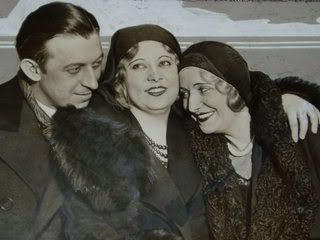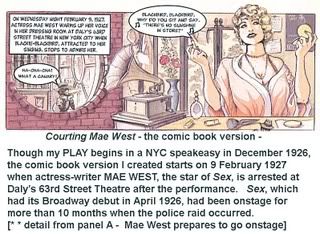Mae West got to know the Jefferson Market Courthouse in 1927. 
• • During the 1920s, the first step towards bringing a play to Broadway was an obligatory stop at the NYC Police Department. In 1926, before Mae West's play "Sex" could be staged at Edward Elsner's Westside playhouse — — Daly's 63rd Street Theatre — — the manuscript had to be approved by a special Police Department Play Jury. [Since 268 plays were produced on Broadway in 1927, squeezed into 70+ theatres, imagine how busy this kept New York City's Play Juries, and think of how much income City Hall raked in from this lucrative licensing arrangement.]
• • Once approved, the text for "Sex" was given a license. Only then could a drama or a comedy be taken forward — — and was it ever!
• • Mae West [1893-1980], who starred as a prostitute in the production, managed to arouse so much interest in her performance in "Sex" that, even though it was dismissed and disparaged by drama critics, her show was a big box office bonanza. In the opening act of "Sex," set in a Montreal brothel, Mae played a song on the piano: "Honey, Let Yo' Drawers Hang Low." In the cabaret scene, she sang two Harlem favorites: "Sweet Man" and "Shake that Thing." Muscle-mamboing Mae also did a sensual belly dance to the "St. Louis Blues."
• • In early April 1926, out-of-town previews had begun in Stamford, Connecticut, then "Sex" went on to Waterbury and then New London, a town on Long Island Sound. Financial backing was supplied by the Morals Production Company, a group of investors organized by Mae's lawyer and lover Jim Timony. Backers included Matilda West, Mae's mother, and the gangster Owney Madden, who also owned the Cotton Club.
• • On April 26, 1926, after those Connecticut try-outs, "Sex" opened on Broadway.
• • Mae West was the draw — — not the play. Nevertheless, the public poured in.
• • By its third week, "Sex" was raking in $10,000 a week.
• • In its seventh week, "Sex" hit the $16,500 mark, then leveled off at a steady $8,000.
• • [In contast, the blockbuster "Broadway" pulled in $31,000 in a single week during 1926.]
• • A steady line of limousines had been pulling up to Daly's entrance. Certain socialites returned to see "Sex" again and again.
• • This interested the District Attorney, who convened a volunteer Play Jury that included one woman, one physician, two Brooklynites, and eight men from Manhattan, and asked them to review the manuscripts of four crowd-pleasing plays once again. In June 1926, this new Play Jury cleared "Sex" of any suspicion of indecency by a vote of 8 to 4. 
• • Ask yourself this:
Why would a play like "Sex," which passed the scrutiny of the Play Jury TWICE [in March and again in June 1926], be raided by the police after ten months of enormous attendance and great publicity — — on Wednesday February 9th, 1927?
• • There are several reasons:
• • • • New York Mayor Jimmy Walker, a fan of Miss West, did not interfere when he heard that the actress was in the midst of planning to stage "The Drag," a play with a homosexual theme that was selecting actors after auditions in gay bars, and planning an out-of-town try-out; and
• • • • On 8 February 1927, Mae had staged a midnight "sneak preview" of "The Drag" at Daly's 63rd Street Theatre, reported Variety Magazine; invited attendees included city officials and several respected physicians, who had been expected to give the play an endorsement; and
• • • • Forty-one weeks into a sellout run of "Sex," Jimmy Walker happened to be out of town and the acting Hizzoner, holier-than-thou Joseph V. McKee, decided to send in the cops. Because of "holy Joe" getting her arrested, and brought to Jefferson Market's Police Court, Mae West wound up spending the night of February 9th in Jefferson Market Jail.
• • After a trial in the Jefferson Market Courthouse during March 1927, Mae West wound up convicted of "corrupting the morals of youth." She was sentenced to ten days in the Women's Workhouse on Welfare Island.
• • "I expect it will be the making of me," she told reporters, and it was: it made her a household name.
• • But "The Drag" died in Mae's dreams and did not open. Via fines, an expensive court battle, and dreadful jail cells, the censors and politicians made their point: there would be no gays on Broadway.
• • The play "Courting Mae West" by Greenwich Village dramatist LindaAnn Loschiavo, set in NYC during 1926 — 1932, explores Mae West's legal woes. Using fictional elements, the text is anchored by true events and has several characters who are based on real people: actress Mae West; Beverly West; Jim Timony; Texas Guinan; Mr. Isidore, a news seller on Sixth Avenue and West 9th Street; and Sara Starr, based on the Greenwich Village flapper Starr Faithfull, whose death inspired John O'Hara's novel "Butterfield 8" and a dozen other books.
• • The project began as a way to keep the Jefferson Market Courthouse's history alive in an entertaining way, so that people could understand more about its significance. And more folks are hearing about it since The New York Law Journal and a few dozen publications have already written about the play. In January 2005, The Jefferson Market Library devoted a month-long art exhibition to sixteen panels that depicted scenes from "Courting Mae West" drawn from archival photos from 1927.
• • The playwright is looking forward to seeing a production of "Courting Mae West" onstage during July 2008 as part of the Annual Fresh Fruit Festival in Manhattan.
• • Mae West had, Colette noted in 1938, an impudent, solitary presence like Chaplin's. Truman Capote once wryly described her curves as "the Big Ben of hour-glass figures," and in the 1920s, when she was starring in her own plays on Broadway, George Jean Nathan wrote that she was "the Statue of Libido." Playfully suggesting that she was less notorious than institutional, Salvador Dali painted a portrait of her face in which the features are pieces of furniture.
• • Mae West still stands alone. Though Mae West wrote her own plays and the dialogue for five Paramount Pictures films, no other actress has written her own dialogue ever. No other actress is quite so quotable nor are there gas pumps, a bend in a road, and a flotation device named for any other actress. You can't escape Mae West. Admit it. You might as well come up and see Mae in "Courting Mae West" this summer.
— — — —
Native New Yorker LindaAnn Loschiavo is a journalist and dramatist as well as a member of the West 9th Street Block Association. In their January 5th, 2005 issue, The Villager did an article about how she discovered four P.A.T.H. exits for the West 9th Street station that Port Authority had "forgotten." Read it online: www.TheVillager.com
• • Get ready to come up and see Mae onstage during July 2008.________________________________________________________________
Source:http://courtingmaewest.blogspot.com/atom.xml Courting Mae West
Courting Mae West
Mae West
• • Illustration: Mae West • • artist ALVARO • •
NYC
Mae West.

Labels: 10011, 1927, Alvaro, Greenwich Village, Jefferson Market Courthouse, Mae West, New York, Sex, Texas Guinan
 Even MAE WEST would have been astonished to see women auditioning to portray the Brooklyn bombshell bringing out the “Birthday Suit” during a New York talent search.
Even MAE WEST would have been astonished to see women auditioning to portray the Brooklyn bombshell bringing out the “Birthday Suit” during a New York talent search.














